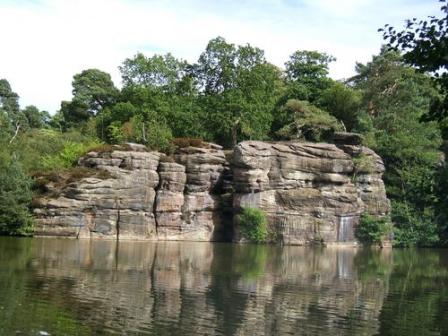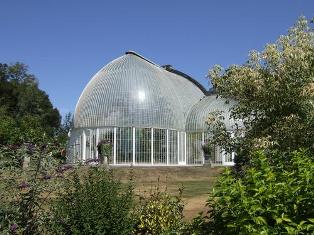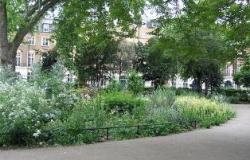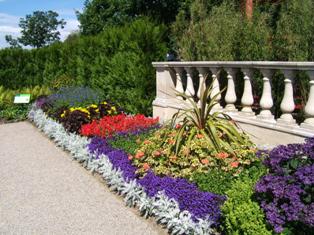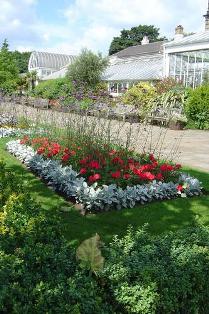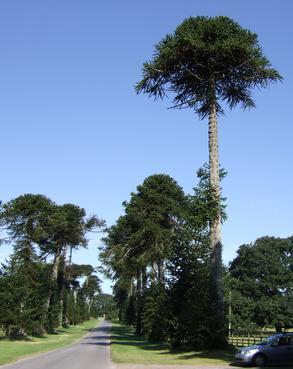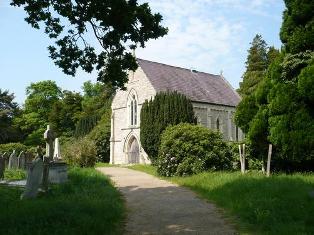The Victorian writer and designer John Claudius Loudon has been described as the ‘father of the English garden’1.
Louise Wickham looks at his work and contribution to the British garden.
Without John Claudius Loudon, it is unlikely that we would have the modern garden in its present form, and indeed the passion (or obsession) for gardening both professionally and as a hobby.
Loudon’s work as a journalist and author led to the ‘democratisation’ of gardening. Through his articles and books, the pleasures of gardening, growing plants and garden visiting became available to people at all levels of society, either in their own modest gardens or in public areas such as parks.
Cheaper printing methods allowed his ideas to be widely dispersed and ‘as the most distinguished gardening author of his age…rather than through his garden designs … Loudon gained historical significance'.[2] It is due to him that the gardener took over from the landscape designer in the 20th century.
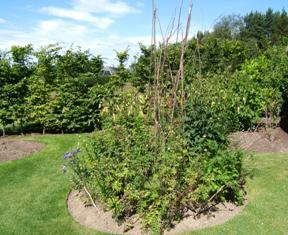
An example of circular beds, typical of gardenesque style. Copyright Louise Wickham
When Loudon was born in 1783, the Landscape movement was at its height, for those who had the land and the wealth to afford it. In contrast, most of the population in England who had access to a garden, carried on gardening in a formal style that had changed little since the 17th century, with a predominance of flowers.
In his early career, Loudon designed in a naturalistic style, while in later years he was at the forefront of the return to formality with his ‘gardenesque’ style of planting. However, as John Harris points out, this was not such an abrupt change as it may seem, as ‘the early 19th-century gardenesque style of Loudon’s day was, in fact, a child of the 18th century’,[3] with its flower beds, serpentine lines and use of shrubs.
Early life
The son of a Scottish farmer, as a child Loudon was given a small plot of land by his father in which he cultivated flowers. After a formal education, his desire to be a landscape gardener was fulfilled at the age of 15, when he was employed as a draughtsman and assistant to John Mawer, a landscape gardener. Here Loudon learnt about the rudiments of gardening and the management of hothouses. In 1799, he became the pupil of another gardener, Dickson, and he studied agriculture for four years at the University of Edinburgh under Dr. Coventry.[4]
In 1803, Loudon left Edinburgh for London and established a thriving landscape gardening practice, due in part to the letters of introduction that Dr. Coventry had given him.
At this stage he was also starting to write: his first published article was about the management of London’s squares and their importance, a subject he would return to later.
Loudon’s first book in 1804 was the snappily titled Observations on the Formation and Management of Useful and Ornamental Plantations, on the Theory and Practice of Landscape Gardening and on Gaining and Embanking Land from Rivers or the Sea.
At this early stage in his career, Loudon was influenced by the ‘Picturesque’ style, advocated by Sir Uvedale Price. Although little remains of his work from this period, his designs ‘delight[ed] in the wild and irregular’.[5]
He was also persuaded by the philosophical arguments of Archibald Alison, that unsophisticated people prefer simple uniformity, as demonstrated by their art and architecture. Loudon believed ‘that this theory accounted for the taste for regular gardens which reigned from earliest times until the end of the 17th century. But in 1806 he thought that the regular style had been rendered obsolete by the advance of civilisation’.[6]
His first commissions
In 1804, Loudon travelled back to Scotland to undertake a commission from the Earl of Mansfield for alterations to the gardens at Scone Palace. He also designed the landscape at Barnbarroch in Wigtonshire between 1805 and 1807, parts of the landscape at Llanarth in 1805, and was at Tan-yr-Allt in 1806.[7] He laid out the pleasure grounds at Ditchley between 1805 and 1810, built the house and surrounding garden at Hope End in 1809 and laid out the grounds of Stradsett Hall between 1810 and 1813.
These designs were in contrast to the relative uniformity of style of the ‘natural’ landscapes designed by Lancelot Brown, Humphry Repton and other professional ‘improvers’.
Loudon was particularly scathing of Brown and his ‘improvements’. He wrote: ‘wherever his levelling hand has appeared, adieu to every natural beauty! See everything give way to one uniform system of smoothing, levelling and clumping of the most tiresome monotony’.[8]
In 1806, Loudon published his third book, A Treatise on Forming, Improving and Managing Country Residences, which expounded his views not only on horticulture but architecture as well. The same year he turned his attention to agriculture by buying Wood Hall Farm in Oxfordshire, indicating that his methods must have been very profitable. While managing nearby Great Tew Park, Loudon established one of the earliest agricultural colleges, which he ran until he left the estate in 1811.
Loudon resumed his landscape gardening practice and the money that he made from it and the farm, enabled him to travel to Europe for the first time in 1813. He visited Sweden and Central Europe before travelling to Russia and Germany. By the time he returned the following year, Loudon had lost his fortune through risky speculation, so he revived his businesses of landscape gardening and writing. In 1818 he prepared a plan for Bullmarsh Court in Berkshire and he was also consulted about plans at Alton Towers, possibly around this time.
His development of hothouses
Loudon concentrated his attention after his first European tour on the development of hothouses. He had written about these as early as 1805 in A Short Treatise on Several Improvements Recently Made in Hothouses. He wanted to make them look beautiful in their own right, and so developed a wrought-iron sash-bar and half-bar in 1816 that could be bent in any direction without losing its strength. His ideas were published in his Remarks on the Construction of Hothouses in 1817 and the following year in A Comparative View of the Common and Curvilinear Modes of Roofing Hothouses. These, and a pamphlet of sketches of experimental hothouses, must have influenced Joseph Paxton, who erected his great conservatory at Chatsworth between 1838 and 1840.
Loudon’s method had been used earlier by W. & D. Bailey who had acquired the rights to the flexible glazing bar in 1818 to produce a greenhouse for Lord St. Vincent.
These developments in glasshouses, together with the introduction of exotic plants with long flowering periods ‘lay behind the fashion for bedding-out exotics …[and] they quickly became essential features of garden architecture’.[9]
In 1823 Loudon designed his own ‘double detached villa’ with a domed conservatory and it was completed in the following year. This was the forerunner of the popular Victorian suburban villa, its garden a model for the gardens that were attached to such houses. The garden’s pathways curved around trees and shrubs, while at the back Loudon laid out experimental raised beds for the exotics.
Development of his 'gardenesque style’
In 1819, he embarked on another European tour: this time to France and Italy. These trips to Europe influenced his thinking on design as he came to admire the great formal gardens of the Continent, particularly in Italy. He was also now changing his philosophical views and aligning them with Quatremère de Quincy, who championed a return to classical aesthetics and Platonic ideals.
Quatremère did not believe that English landscape gardening could be considered one of the fine arts. Loudon’s response was his ‘gardenesque’ style, which he developed over the next 20 years.
According to Turner, ‘Loudon’s conversion to the Italian style is one of the great turning points in the history of English garden design. He was the first theoretician to realise that the century-long quest to imitate ever-wilder versions of nature had led to a dead end’.[10]
The following year Loudon began his first large-scale literary work, the Encyclopaedia of Gardening, which he completed in 1822. The encyclopaedia was to go through nine editions, its popularity due to its comprehensive nature, as it encompassed the historical, technical, aesthetic and horticultural aspects of gardening. In this work, Loudon returned to the theme of creating of new public spaces, particularly in large cities. He reflected that, unlike its continental neighbours, Britain had few places for its citizens to promenade by horse or on foot. In 1829 he wrote an article called Breathing Places for the Metropolis in which ‘the idea of a circular promenade was developed into an extremely far-sighted greenbelt proposal’.[11] He designed St Peter’s Square in Hammersmith, London in about 1825.
Loudon’s campaign for public parks, particularly in London, was taken up by politicians and led to the creation of Victoria Park in Bow. He also designed a park at Gravesend in 1835, but this was sold for building development in 1875. Its planting scheme appeared ‘to be based on Loudon’s 1812 proposal for a circular botanical garden. The 1812 plan has a spiral path which enabled plants to be viewed in their correct sequence and a cross axis which returned the visitor to the starting point’.[12]
Loudon, the journalist
In 1826, Loudon founded his successful journal, The Gardener’s Magazine, which continued for 19 years. Initially it was published quarterly, then bi-monthly, and finally monthly. It ‘was a survey of contemporary domestic and foreign horticultural affairs including book reviews and educational articles for gardeners. It also provided Loudon with an organ for his own personal and trenchant opinions’.[13]The Gardener’s Magazine was not the first gardening journal, but it certainly was one of the most influential due to the quality of its writing and its large middle-class audience. Loudon’s personal reports of the garden tours that he undertook led to ‘garden tourism’ becoming the popular pastime that it remains today.
Loudon married Jane Webb in 1830. She was a novelist, and after her marriage Jane Loudonbecame a well-known writer on horticulture and botany - the first woman to do so. Her books were aimed at the growing number of middle- and upper-class women who were interested in gardening. She encouraged use of the bedding schemes that became so popular in the Victorian period, their intricate displays being changed three times a year. The design of these, she argued, was particularly appropriate for the ladies of the house as they had the necessary degree of taste and artistic feeling. Jane Loudon paved the way for the famous plantswomen of the late 19th and early 20th centuries such as Gertrude Jekyll and Vita Sackville-West.
In 1831 Loudon undertook the planning of the Birmingham Botanical Garden. The design shows his return to formality, with more straight paths and ordered areas such as ‘parterres for annuals and a rosary…a botanical garden of trees, shrubs and perennials…a flower garden…an orchard and fruit nursery…(and) a kitchen garden and agricultural garden’.[14]
At Birmingham, Loudon’s views on what he termed ‘gardenesque’ planting began to take shape, and he first used the term in The Gardener’s Magazine in 1832.
The inclusion of exotic trees and shrubs (correctly labelled) were known as the ‘Principle of Recognition’.In the first edition of the magazine in 1826, Loudon had observed that ‘landscape gardening about a century ago was as much the fashion as horticulture is at present’, meaning that the contents of the garden were now of more importance than its overall design. The reason for this shift in emphasis was primarily ‘the enormous inflow of new plants … from (new) lands’.[15] While the gardenesque is often derided today as a mixed - or even rather confused – style, with certain plants given prominence, its circular beds are still much used today.
1838 saw the publication of The Surburban Gardener and Villa Companion, which re-stated Loudon’s view that the key to a successful garden was to match the style with the size. While flowing, informal lines worked well for a large estate (100 acres or more), a more formal, geometric layout suited the smaller plot.
In the same year, Loudon published another of his major works: Arboretum et Fruiticetum Britannicum, which was designed to encourage ‘gentlemen of landed property …(to introduce) a greater variety of trees and shrubs in their plantations and pleasure grounds’.[16] His ideas were put into practice at Bictonwhere he gave advice on the arboretum and the design of the Monkey Puzzle Avenue, laid out in 1842.
Public parks and cemeteries
In 1839 Loudon received his second commission for a public park: the Derby Arboretum. Joseph Strutt, the owner, had wanted to create a botanical garden, but was persuaded that this would be too expensive to maintain. He therefore ‘commissioned Loudon to create a ‘Pleasure Ground or Recreation Ground to offer the inhabitants of the town the opportunity of enjoying, with their families, exercise and recreation in the fresh air, in public walks and grounds devoted to that purpose’.[17] Loudon compromised between this and the idea of a botanical garden by planting valuable trees and shrubs from around the world while leaving some open spaces.
Loudon’s work at Derby and his writings greatly influenced Joseph Hooker, whose layout ofKew Gardens with accurate botanical labelling became the model for all subsequent botanical gardens.
In 1841, Loudon created a plan for the gardens at Castle Kennedy, which incorporated many of his later design ideas including the use of exotic specimen such as monkey puzzle trees.
In 1843 - the last year of his life - Loudon concerned himself with the layout and planning of cemeteries. Graveyards in the large towns and cities were full and badly kept and he advocated that new cemeteries be built, such as Père-Lachaise in Paris.
Loudon visited the first new ‘necropolis’, which had been built in Glasgow in 1831, and much admired its ‘totally different character…and … nothing of the untidy effect of English cemeteries’.[18] Other cities followed, including London, and Loudon’s ideas on design were influential, particularly in the use of mainly evergreen trees and shrubs to make the area pleasant.
His ideas were set out in his last book On the Laying out, Planting, and the Managing of Cemeteries, and on the Improvement of Churchyards. This was based on his experience of designing the Histon Road Cemetery in Cambridge, Southampton Old Cemetery and Abbey Cemetery, Bath.
His legacy
Today there are only a few surviving gardens designed by Loudon in their original form. However his main contribution was that he truly took gardening to the masses. ‘He made (garden) owners realise what was possible – what they might aspire to and how it might be achieved’.[19]
His predecessors had largely confined their attention to large estates, but Loudon tried to ensure that everyone had the chance to enjoy plants and a pleasant environment. He promoted horticulture in smaller (usually suburban) gardens and provided public parks and ‘green belts’ around large cities. Through the development of his ‘gardenesque’ style and his improvements to the design of greenhouse, Loudon helped encourage the diversity of plant material within gardens that continues today.
Further Reading
Ballard, Phillada (1985) ‘Loudon and the Birmingham Botanical Garden’ Garden History vol 8, no 2, pp.66-74.
Boniface, Priscilla ed. (1987) In Search of English Gardens: The Travels of John Claudius Loudon and his Wife Jane.
Curl, James Stevens (1985) ‘Loudon and the Garden Cemetery Movement’ Garden Historyvol 11, no 2, pp.133-156.
Gloag, John (1970) Mr Loudon’s England.
MacDougall, Elisabeth ed. (1980) John Claudius Loudon and the Early Nineteenth Century in Great Britain.
Simo, Melanie (1983) ‘John Claudius Loudon on Planning and Design for the Garden Metropolis’ Garden History vol 9, No 2
Turner, Tom (1982) ‘Loudon’s Stylistic Development’ Journal of Garden History vol 2, no 2, pp175-188.
Turner, Tom (1982) ‘John Claudius Loudon and the Public Park’ Landscape DesignNovember, pp.33-35.
Endnotes
- Fleming, Laurence & Gore, Alan (1979) The English Garden, p171.
- Adams, William Howard (1991) Nature Perfected: Gardens through History, p187.
- Harris John (1979) ‘The flower garden 1730 to 1830’ in Harris, John (ed.) The Garden a Celebration of British Gardening, p41.
- Gloag, John (1970) Mr Loudon’s England, p24.
- Turner, Tom (1982) ‘Loudon’s Stylistic Development’ Journal of Garden History vol 2, no 2, p175.
- Loudon, Jane (1845) ‘An Account of the Life and Writings of John Claudius Loudon’ reprinted in MacDougall, Elisabeth (1980) John Claudius Loudon and the Early Nineteenth Century in Great Britain, p15.
- Turner, Tom (1982) ‘Loudon’s Stylistic Development’ Journal of Garden History vol 2, no 2, p179.
- Loudon, John Claudius (1804) Observations on the Formation and Management of Useful and Ornamental Plantations, on the Theory and Practice of Landscape Gardening and on Gaining and Embanking Land from Rivers or the Sea quoted in Turner, Tom (1986) English Garden Design: History and Styles since 1650, p41.
- Elliott, Brent (1979) Victorian garden design in Harris, John (ed.) The Garden a Celebration of British Gardening, p57.
- Turner, Tom (1986) English Garden Design: History and Styles since 1650, p131.
- Turner, T.H. D. (1982) ‘John Claudius Loudon and the Public Park’ Landscape DesignNovember, p33.
- Turner, T.H. D. (1982) ‘John Claudius Loudon and the Public Park’ Landscape DesignNovember, p35.
- Hobhouse, Penelope (2002) The Story of Gardening, p252.
- Ballard, Phillada (1985) ‘Loudon and the Birmingham Botanical Garden’ Garden Historyvol 8, no 2, p68.
- Gorer, Richard (1979) ‘The Gardenesque Garden 1830 to 1890’ in Harris, John (ed.) The Garden a Celebration of British Gardening, p47.
- Loudon, John Claudius (1838) Arboretum et Fruiticetum Britannicum quoted in Gloag, John (1970) Mr Loudon’s England, p63.
- www.derbyarboretum.co.uk (consulted April 2004).
- Curl, James Stevens (1985) ‘Loudon and the Garden Cemetery Movement’ Garden History vol 11, no 2, p140.
- Quest-Ritson, Charles (2001) The English Garden: A Social History, p178.

